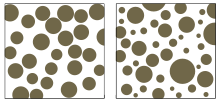Color
The color of a sedimentary rock is often mostly determined by iron, an element with two major oxides: iron(II) oxide and iron(III) oxide. Iron(II) oxide (FeO) only forms under low oxygen (anoxic) circumstances and gives the rock a grey or greenish colour. Iron(III) oxide (Fe2O3) in a richer iron environment is often found in the form of the mineral hematite and gives the rock a reddish to brownish colour. In arid continental climates rocks are in direct contact with the atmosphere, and oxidation is an important process, giving the rock a red or orange colour. Thick sequences of red sedimentary rocks formed in arid climates are called red beds. However, a red colour does not necessarily mean the rock formed in a continental environment or arid climate.[8]The presence of organic material can colour a rock black or grey. Organic material is formed from dead organisms, mostly plants. Normally, such material eventually decays by oxidation or bacterial activity. Under anoxic circumstances, however, organic material cannot decay and leaves a dark sediment, rich in organic material. This can, for example, occur at the bottom of deep seas and lakes. There is little water mixing in such environments, as a result oxygen from surface water is not brought down, and the deposited sediment is normally a fine dark clay. Dark rocks, rich in organic material, are therefore often shales.[8][9]
Texture
Diagram showing well-sorted (left) and poorly sorted (right) grains
The 3D orientation of the clasts is called the fabric of the rock. Between the clasts, the rock can be composed of a matrix (a cement) that consists of crystals of one or more precipitated minerals. The size and form of clasts can be used to determine the velocity and direction of current in the sedimentary environment that moved the clasts from their origin; fine, calcareous mud only settles in quiet water while gravel and larger clasts are moved only by rapidly moving water.[11][12] The grain size of a rock is usually expressed with the Wentworth scale, though alternative scales are sometimes used. The grain size can be expressed as a diameter or a volume, and is always an average value – a rock is composed of clasts with different sizes. The statistical distribution of grain sizes is different for different rock types and is described in a property called the sorting of the rock. When all clasts are more or less of the same size, the rock is called 'well-sorted', and when there is a large spread in grain size, the rock is called 'poorly sorted'.[13][14]
Diagram showing the rounding and sphericity of grains
Coquina, a rock composed of clasts of broken shells, can only form in energetic water. The form of a clast can be described by using four parameters:[15][16]
- Surface texture describes the amount of small-scale relief of the surface of a grain that is too small to influence the general shape.
- rounding describes the general smoothness of the shape of a grain.
- 'Sphericity' describes the degree to which the grain approaches a sphere.
- 'Grain form' describes the three dimensional shape of the grain.
Mineralogy
Most sedimentary rocks contain either quartz (especially siliciclastic rocks) or calcite (especially carbonate rocks). In contrast to igneous and metamorphic rocks, a sedimentary rock usually contains very few different major minerals. However, the origin of the minerals in a sedimentary rock is often more complex than in an igneous rock. Minerals in a sedimentary rock can have formed by precipitation during sedimentation or by diagenesis. In the second case, the mineral precipitate can have grown over an older generation of cement.[17] A complex diagenetic history can be studied by optical mineralogy, using a petrographic microscope.Carbonate rocks dominantly consist of carbonate minerals such as calcite, aragonite or dolomite. Both the cement and the clasts (including fossils and ooids) of a carbonate sedimentary rock can consist of carbonate minerals. The mineralogy of a clastic rock is determined by the material supplied by the source area, the manner of its transport to the place of deposition and the stability of that particular mineral. The resistance of rock forming minerals to weathering is expressed by Bowen's reaction series. In this series, quartz is the most stable, followed by feldspar, micas, and finally other less stable minerals that are only present when little weathering has occurred.[18] The amount of weathering depends mainly on the distance to the source area, the local climate and the time it took for the sediment to be transported to the point where it is deposited. In most sedimentary rocks, mica, feldspar and less stable minerals have been reduced to clay minerals like kaolinite, illite or smectite.[clarification needed]


No comments:
Post a Comment